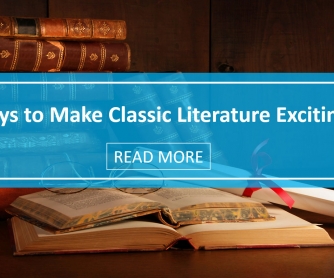
Mention that you are going to read a play by Shakespeare or one of Charles Dickens’ classics and many students groan. These are some of the greatest literary works of all time, but students are put off by archaic language and plot lines they think are not relevant to their own lives. Teachers must work to get past the archaic language and help students realize how exciting and relevant these classic novels can actually be.
Put Students into the Literature
The more students are involved in reading literature, the more interested they are. As students read classic novels, give them a role to play. This is easy to do with a Shakespearean play because students can simply take turns portraying the different characters in class. However, reading dialogue from a play is not the only way to get students involved in the text. A simple way to do this is by conducting a reader’s theater where students are assigned a portion of the text and must read it dramatically, adding movement or images to help enhance the text.
Assigning a specific character to each student can also be used to help get them involved in a text. As they read, students can pretend to keep a diary from the character’s perspective, tweet and post status updates as if they were the character or even take on that character’s persona while participating in class discussions and other role playing activities. Teachers can also have students put themselves directly into the novel, having them blog as if they were bystanders in the novel or rewrite a passage to include themselves as a new character.
Make Real-Life Connections
Students can also get involved in literature by making connections between what they read and what is going on in the world around them. One of the reasons classic literature is still taught today is because of its timeless themes and relevance to the world today. If students can see that the literature is relevant to their lives, they are more likely to be interested in the text. Getting students to relate to the characters of the novel is one of the easiest ways to get them interested in a text. Ask questions such as:
- Which character do you relate to the most?
- How would you have reacted to that situation?
- Does that remind you of anything that has happened in your life?
You can also get students to make real-life connections by having them explore a theme, focusing not only how that theme appears in the text, but also how it appears in other texts, current events and events in their own lives. Reward students with extra credit for bringing in articles from newspapers and magazines that connect with major themes in the text. Have them update a passage of the text so that it is set in modern times and discuss what changes they made and why.
Change the Format
Changing the format can also help students see a piece of classic literature as something more interesting and relevant. The minute you assign a classic text, most students immediately start searching for movies based on the text. Beat them to the punch by showing students the movie version of a text before reading the book or encourage students to watch the movie on their own to give them a point of reference and something to compare the novel with as they read. Even movies that are loosely based on classic novels, including those set in modern times, can help get students interested in the book. Many classic novels are also now available as graphic novels, picture books and in other unique formats. If no movie versions or unique formats of a text are available, put students to work. They can create their own comic books, write their own poems or make their own videos based on passages of the text.
Classic literature is an important part of a language arts curriculum and can help students become stronger readers and thinkers. However, all of the benefits of classic literature are lost if students do not like what they are reading. Putting them into the text and helping them see classic literature in new ways can make a world of difference when it comes to reading these timelessP.S. If you enjoyed this article, please help spread it by clicking one of those sharing buttons below. And if you are interested in more, you should follow our Facebook page where we share more about creative, non-boring ways to teach English.








